Papers by GABRIEL DIAZ MONTEMAYOR
Modular Approach to Colonia Landscapes in Texas’ Lower Rio Grande Valley
The Plan Journal
Field Notes on Design Activism: 7
Places Journal
Architects need to envision more just futures, and there is no more urgent issue than housing jus... more Architects need to envision more just futures, and there is no more urgent issue than housing justice. We need to work in solidarity with allies, and we need to organize.
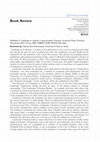
Environment and Planning B: Urban Analytics and City Science, 2016
at Austin ''Landscape as Urbanism'' is written as the culmination, so far, of an evolving process... more at Austin ''Landscape as Urbanism'' is written as the culmination, so far, of an evolving process which has, during the past 20 years, produced the idea that Landscape can and should be the foundation for the urbanism of the twenty-first century. This process has included articles, exhibitions, and symposia producing articles, some of which have been adapted to be part of this book. Its direct precedent is titled ''The Landscape Urbanism Reader'' edited by the same author and published in 2006. At the time, 10 years ago, this edited volume included a number of articles written by authors which continue today to contribute to the general idea of landscape as urbanism in the new book. Landscape Urbanism, the neologism most often used for the main idea in ''Landscape as Urbanism,'' has been articulated by a number of academics and practitioners but has eventually become concentrated in the Graduate School of Design (GSD) at Harvard University. As a General Theory, ''Landscape as Urbanism'' is presented as an acting idea among other recently proposed in books such as ''Ecological Urbanism'' (Mostafavi, 2010) and ''Projective Ecologies'' (Lister and Reed, 2014), also published by the GSD. The relevance of ''Landscape as Urbanism'' for those of us who have been educated in Landscape Architecture during the first 16 years of the present century is certainly outstanding. ''The Landscape Urbanism Reader,'' for example, has been used almost like a textbook by numerous programs in the USA, and ''Landscape as Urbanism'' is posed to be a welcome addition to the ongoing debate pertaining how to respond to a world where most of the population lives in urban areas and social and environmental crises are unfolding. Landscape Urbanism, the neologism, has been a contentious proposition in the context of the current trajectories of urban design. These are addressed in the book. Currently, one of the most effervescent debates is the opposition between Landscape Urbanism and the ideas revolving around New Urbanism. Landscape Urbanism is footed in the conviction that, in the current contemporary urban condition of the western world, suburban areas have and will continue to dominate the urban realm. New Urbanists advocate for density, intensity, and, many claim, a nostalgic pre-car-oriented urban form; Landscape Urbanism advocates indeterminacy and an infrastructure capable to accept process, succession, and change. It is probable that this duel will go on, even more so with the publication of this book. Landscape Urbanism looks at issues which have not been of the attention of other urban design movements. Of particular note is the focus on post-industrial, post-urban, or postinfrastructural sites. As exemplified by a number of brownfield projects, such as the Freshkills Park in Staten Island, or the re-emergence of the City of Detroit, or the reuse of large airport sites, the revelation of the capacities to reoccupy these spaces by hand of Environment and Planning B: Planning and Design 0(0) 1-2 ! The Author(s) 2016 Reprints and permissions: sagepub.co.uk/journalsPermissions.nav
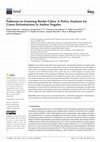
Land
Green infrastructure (GI) has been proposed as a decentralized solution to complex urban water ma... more Green infrastructure (GI) has been proposed as a decentralized solution to complex urban water management issues. However, public policy remains a critical challenge for the wide adoption of GI, which is exacerbated in transboundary settings. We draw from public policy theory to analyze GI policies at the US–Mexico border. We examine the case of Ambos Nogales—two sister cities grappling with complex water management challenges. We examined existing policies and evaluated their impact on the implementation of GI at multiple levels (local, state, national, and binational). We also conducted interviews and a focus group with stakeholders. Our analysis unveils a set of barriers to the adoption of GI and a suite of opportunities for the enactment of GI policies. We outline five pathways for greening border cities, including (i) creating market-based GI incentives, (ii) adopting the net-zero urban water approach, (iii) engaging with existing institutions for greening efforts, (iv) plannin...
Urban and environmental regeneration in Mexican cities: a design framework
Journal of Urbanism: International Research on Placemaking and Urban Sustainability
The social and environmental crises of Mexican cities demand an urgent search for solutions throu... more The social and environmental crises of Mexican cities demand an urgent search for solutions through design projects capable of both mitigation and recovery. This article proposes a design framework...
Ciudades Integrales Para Tamaulipas
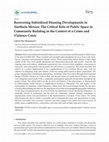
Sustainability, 2019
México has subsidized and built millions of low-income homes and thousands of subdivisions in the... more México has subsidized and built millions of low-income homes and thousands of subdivisions in the period of 2000–2012. These occupied and expanded urban peripheries far away from work, learn, service, commerce, and recreational amenity centers. These communities had no chance to offer a high quality of life. They were rapidly abandoned and deteriorated physically and socially. Amid the still ongoing crime and violence, inhabitants experienced a loss of trust in their neighbors, a deep sense of insecurity, and consequently reduced public life and activity to a minimum. This article describes and reflects on a project implemented in two neighborhoods of two northern México cities, with the objective of mitigating crime and violence, while recovering public spaces in these communities. The project implemented a hybridized methodology, including Crime Prevention Through Environmental Design (CPTED), attention to Youth at Risk, and the prevention of Gender Based Violence. All these were ...

Urban and environmental regeneration in Mexican cities: a design framework
Journal of Urbanism: International Research on Placemaking and Urban Sustainability, 2022
The social and environmental crises of Mexican cities demand an urgent search for solutions throu... more The social and environmental crises of Mexican cities demand an urgent search for solutions through design projects capable of both mitigation and recovery. This article proposes a design framework for projects that can result in an urban and environmental regeneration for these cities. This framework uses the concepts of territorial scale, hybrid systems, and urban ecotones, and it results from a revision of emerging theories and the application of the frame- work in two design projects in Mexico: A Green Corridor System for Hermosillo and a Blue Ring for Tampico. The proposed design framework contributes to the emerging planning context in Mexico while employing existing tools and studies. The article concludes that the proposed design framework can reinforce territorial identities by facilitating the regeneration of the urban artifact and by enabling the use natural ecosystems.
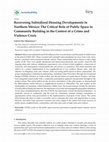
Sustainability Journal, 2019
México has subsidized and built millions of low-income homes and thousands of subdivisions in the... more México has subsidized and built millions of low-income homes and thousands of subdivisions in the period of 2000-2012. These occupied and expanded urban peripheries far away from work, learn, service, commerce, and recreational amenity centers. These communities had no chance to offer a high quality of life. They were rapidly abandoned and deteriorated physically and socially. Amid the still ongoing crime and violence, inhabitants experienced a loss of trust in their neighbors, a deep sense of insecurity, and consequently reduced public life and activity to a minimum. This article describes and reflects on a project implemented in two neighborhoods of two northern México cities, with the objective of mitigating crime and violence, while recovering public spaces in these communities. The project implemented a hybridized methodology, including Crime Prevention Through Environmental Design (CPTED), attention to Youth at Risk, and the prevention of Gender Based Violence. All these were integrated transversally with a community participation approach incorporated throughout the project actions. This article reflects on the successes and failures of this pilot project, as demonstrated by differentiated results between a neighborhood located in Chihuahua City and another in the municipality of Guadalupe, within Monterrey's Metro Area. The lessons learned, include the relevance of local political timing and interests, the importance of accurate and manageable geographic definitions for the areas of implementation, the role of NGOs, the importance of local educational institutions-in particular schools of architecture and the need for community oriented strategic consultants, to appropriately advise local governments in the implementation of projects of this nature. The article demonstrates the effort to make it accessible, and to anticipate the issues and opportunities as many Mexican, and other Latin American countries and cities engage in the spatial and social recovery of public spaces, neighborhoods, communities, and cities after years of high crime and violence.
Retrofitting Sprawl, 2015
ENVIRONMENT AND PLANNING B, 2016
The second section addresses the urban climate challenge. In particular, this section tries to an... more The second section addresses the urban climate challenge. In particular, this section tries to answer the main question why and how cities can have a role in reduction of greenhouse gases emissions, analyzing cities current efforts, examples and policies involving energy, buildings, waste, transportation and deforestation.

Mexican urban peripheries grew exponentially after an agricultural land-ownership deregulation de... more Mexican urban peripheries grew exponentially after an agricultural land-ownership deregulation derived from NAFTA and after 12 years of a federal policy determined on diminishing housing deficits by the construction of millions of subsidized homes. The physical outcome of this policy are hundreds of low income subdivisions marooned and isolated in wide and largely vacant peripheries, far away from employment, service, commerce, and recreational centers.
This policy was favored by 2 presidents coming from the same political party between 2000 and 2012. In late 2012 a new president came to office from a different political party. The new government immediately acknowledged the urban and social disaster provoked by the centrifugal growth policy and created a new federal ministry for urban and territorial development to address these issues. This new ministry is currently developing policies and guidelines to reverse growth to a centripetal, subsidized urban infill pattern. This change is promising given the grave problems derived from lack of infrastructure, social cohesion, and weak economy. The situation is particularly unique in northern Mexico, where in those same years and against the backdrop of a barren landscape, crime and violence surged, emptying many peripheral subdivisions.
What will happen with the hundreds of subdivisions and millions of homes and people scattered in ample peripheries which will take many years, if ever, to become integrated components of the city?
This paper first maps, measures, and characterizes the current conditions of these fringes in 5 cities of northern Mexico. Local planning institutes and the National Institute for Statistics and Geography (INEGI) provide with up-to-date maps, historical maps, and urban data, while the former also supply their preliminary responses to the new federal policy. This initial analysis confirms regional patterns and a repertoire of issues and stimuli. Secondly, the investigation proceeds to conceptually intersect these conditions with contemporary ideas of urbanism such as Sustainable Urbanism, Landscape Urbanism, and Ecological Urbanism. This conceptual testing determines unforeseen opportunities for the urban peripheries in the economy driven / media heavy public perception of the problem.
Finally, one prototypical urban periphery is visualized in diagrams, maps, and renderings exploring its integration with the landscape and the city, from the inside-out and outside-in. Envisioning decaying subdivisions turned resilient communities tied to their ground by a mix of top-down and bottom-up actions to appropriate vacancies both outside of their limits and inside, with a mixed use, dense, intense, and diverse development where abandoned lots and buildings are retrofitted into community programs, while site specific qualities relate to regions and ecosystems. This detailed testing also operates as a catalyst to understand the conditions that separate those subdivisions with a capacity to thrive in the new urban growth policy against those that do not.
In a XXI century plenty of red-fields being conceptualized as green-fields, millions of foreclosed homes and unfinished housing developments; the neighborhoods and communities of the expanded Mexican peripheries provide an invaluable laboratory to investigate the sustainability and recovery of the many now left behind in both the developing and first worlds.
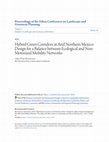
Proceedings of the Fábos Conference on Landscape and Greenway Planning, 2016
Since the emergence of decentralized Municipal Planning Institutes in the XXI century, many Mexic... more Since the emergence of decentralized Municipal Planning Institutes in the XXI century, many Mexican cities have included in their urban plans both proposals for green networks along waterways and non-motorized networks. The recovery of urban waterways is critical as these have historically been neglected and polluted. The promotion of non-motorized mobility networks is now critical in the context of low standards of public space, derived from a rapid and sprawling urbanization, and health, derived from epidemic conditions related to diabetes and heart disease.
There is a growing public awareness of ecology and the relationships between public space and public health. Citizen activist groups are being organized promoting the use of bicycles and walking. Ecological concerns in arid Northern Mexico are yet to catch up among the public, but the local planning institutions are updating urban plans including and promoting sustainable concepts. This study develops the integration of waterway and non-motorized networks focusing on enhancing their capacity towards implementation. This is done by modeling and designing the networks so that planning concepts which are still fairly basic in urban plans can be further advanced and specified. These plans and designs allow for a better capacity to socialize and disseminate concepts which are not yet part of the local collective imaginary.
The planning approach to waterway, as green corridor networks, and non-motorized mobility networks varies from city to city. Sometimes both are planned as separate systems, sometimes both are planned as integral one to the other. While both networks remain mostly unimplemented at this point, it is the non-motorized mobility network the one that has been more successful in its implementation. This is due to the fact that wider sidewalks and bicycle lanes are easier to be inserted into a conventional street or avenue when compared to the infrastructural construction and maintenance required to recover an urban waterway.
Arid Northern Mexico cities offer a wide range of geographical and ecological conditions. Some, like Chihuahua or the urban area of Los Cabos, have mostly unrelated or conflicting natural waterway networks and conventional street networks. This condition has shaped the planning of green and non-motorized mobility networks into a hybrid.
Other cities, like Hermosillo, Sonora, and Mexicali, Baja California, exist in flat valleys where waterways are mostly artificial infrastructures which were built to convey water away from urban areas or as irrigation canals. These infrastructures have slowly become part of the urban fabric as the city grows. The presence of these waterways is not as obvious when compared to cities with wide rivers and washes carved by accentuated topography or tropical storms. These two cities are currently in the process of developing plans for non-motorized and green corridor networks. This paper makes the case to accept how already integrated the street networks and artificial waterway networks are. If these two programs are conceptualized together as an integrated hybrid, and not as separate systems, the feasibility for implementation is greatly improved, as well as its urban effectiveness.
To demonstrate this, this study analyzed both cities through GIS cartographic analysis to: reveal how integrated waterways and streets are, explain how areas of origin and destinations can be connected through the hybrid networks, visualize how this hybrid approach results in shorter distances if non-motorized networks were conceptualized only on streets and not in and along waterways.
To support these findings, the study includes a collaborative project between the Municipal Planning Institute of Hermosillo and a Landscape Architecture / Urban Design Graduate studio where the modeling of the network and the design of the green corridors demonstrates how green corridors can be made part of mobility corridors. Working on the existing conditions of the proposed green networks confirm that multiple objectives can be achieved: efficient non-motorized mobility, water management, the employment of local construction techniques, and spatial quality to make these public space corridors attractive to the general population. These concepts are also extrapolated and demonstrated in a hybrid network and corridor designs for Mexicali.











Uploads
Papers by GABRIEL DIAZ MONTEMAYOR
This policy was favored by 2 presidents coming from the same political party between 2000 and 2012. In late 2012 a new president came to office from a different political party. The new government immediately acknowledged the urban and social disaster provoked by the centrifugal growth policy and created a new federal ministry for urban and territorial development to address these issues. This new ministry is currently developing policies and guidelines to reverse growth to a centripetal, subsidized urban infill pattern. This change is promising given the grave problems derived from lack of infrastructure, social cohesion, and weak economy. The situation is particularly unique in northern Mexico, where in those same years and against the backdrop of a barren landscape, crime and violence surged, emptying many peripheral subdivisions.
What will happen with the hundreds of subdivisions and millions of homes and people scattered in ample peripheries which will take many years, if ever, to become integrated components of the city?
This paper first maps, measures, and characterizes the current conditions of these fringes in 5 cities of northern Mexico. Local planning institutes and the National Institute for Statistics and Geography (INEGI) provide with up-to-date maps, historical maps, and urban data, while the former also supply their preliminary responses to the new federal policy. This initial analysis confirms regional patterns and a repertoire of issues and stimuli. Secondly, the investigation proceeds to conceptually intersect these conditions with contemporary ideas of urbanism such as Sustainable Urbanism, Landscape Urbanism, and Ecological Urbanism. This conceptual testing determines unforeseen opportunities for the urban peripheries in the economy driven / media heavy public perception of the problem.
Finally, one prototypical urban periphery is visualized in diagrams, maps, and renderings exploring its integration with the landscape and the city, from the inside-out and outside-in. Envisioning decaying subdivisions turned resilient communities tied to their ground by a mix of top-down and bottom-up actions to appropriate vacancies both outside of their limits and inside, with a mixed use, dense, intense, and diverse development where abandoned lots and buildings are retrofitted into community programs, while site specific qualities relate to regions and ecosystems. This detailed testing also operates as a catalyst to understand the conditions that separate those subdivisions with a capacity to thrive in the new urban growth policy against those that do not.
In a XXI century plenty of red-fields being conceptualized as green-fields, millions of foreclosed homes and unfinished housing developments; the neighborhoods and communities of the expanded Mexican peripheries provide an invaluable laboratory to investigate the sustainability and recovery of the many now left behind in both the developing and first worlds.
There is a growing public awareness of ecology and the relationships between public space and public health. Citizen activist groups are being organized promoting the use of bicycles and walking. Ecological concerns in arid Northern Mexico are yet to catch up among the public, but the local planning institutions are updating urban plans including and promoting sustainable concepts. This study develops the integration of waterway and non-motorized networks focusing on enhancing their capacity towards implementation. This is done by modeling and designing the networks so that planning concepts which are still fairly basic in urban plans can be further advanced and specified. These plans and designs allow for a better capacity to socialize and disseminate concepts which are not yet part of the local collective imaginary.
The planning approach to waterway, as green corridor networks, and non-motorized mobility networks varies from city to city. Sometimes both are planned as separate systems, sometimes both are planned as integral one to the other. While both networks remain mostly unimplemented at this point, it is the non-motorized mobility network the one that has been more successful in its implementation. This is due to the fact that wider sidewalks and bicycle lanes are easier to be inserted into a conventional street or avenue when compared to the infrastructural construction and maintenance required to recover an urban waterway.
Arid Northern Mexico cities offer a wide range of geographical and ecological conditions. Some, like Chihuahua or the urban area of Los Cabos, have mostly unrelated or conflicting natural waterway networks and conventional street networks. This condition has shaped the planning of green and non-motorized mobility networks into a hybrid.
Other cities, like Hermosillo, Sonora, and Mexicali, Baja California, exist in flat valleys where waterways are mostly artificial infrastructures which were built to convey water away from urban areas or as irrigation canals. These infrastructures have slowly become part of the urban fabric as the city grows. The presence of these waterways is not as obvious when compared to cities with wide rivers and washes carved by accentuated topography or tropical storms. These two cities are currently in the process of developing plans for non-motorized and green corridor networks. This paper makes the case to accept how already integrated the street networks and artificial waterway networks are. If these two programs are conceptualized together as an integrated hybrid, and not as separate systems, the feasibility for implementation is greatly improved, as well as its urban effectiveness.
To demonstrate this, this study analyzed both cities through GIS cartographic analysis to: reveal how integrated waterways and streets are, explain how areas of origin and destinations can be connected through the hybrid networks, visualize how this hybrid approach results in shorter distances if non-motorized networks were conceptualized only on streets and not in and along waterways.
To support these findings, the study includes a collaborative project between the Municipal Planning Institute of Hermosillo and a Landscape Architecture / Urban Design Graduate studio where the modeling of the network and the design of the green corridors demonstrates how green corridors can be made part of mobility corridors. Working on the existing conditions of the proposed green networks confirm that multiple objectives can be achieved: efficient non-motorized mobility, water management, the employment of local construction techniques, and spatial quality to make these public space corridors attractive to the general population. These concepts are also extrapolated and demonstrated in a hybrid network and corridor designs for Mexicali.
This policy was favored by 2 presidents coming from the same political party between 2000 and 2012. In late 2012 a new president came to office from a different political party. The new government immediately acknowledged the urban and social disaster provoked by the centrifugal growth policy and created a new federal ministry for urban and territorial development to address these issues. This new ministry is currently developing policies and guidelines to reverse growth to a centripetal, subsidized urban infill pattern. This change is promising given the grave problems derived from lack of infrastructure, social cohesion, and weak economy. The situation is particularly unique in northern Mexico, where in those same years and against the backdrop of a barren landscape, crime and violence surged, emptying many peripheral subdivisions.
What will happen with the hundreds of subdivisions and millions of homes and people scattered in ample peripheries which will take many years, if ever, to become integrated components of the city?
This paper first maps, measures, and characterizes the current conditions of these fringes in 5 cities of northern Mexico. Local planning institutes and the National Institute for Statistics and Geography (INEGI) provide with up-to-date maps, historical maps, and urban data, while the former also supply their preliminary responses to the new federal policy. This initial analysis confirms regional patterns and a repertoire of issues and stimuli. Secondly, the investigation proceeds to conceptually intersect these conditions with contemporary ideas of urbanism such as Sustainable Urbanism, Landscape Urbanism, and Ecological Urbanism. This conceptual testing determines unforeseen opportunities for the urban peripheries in the economy driven / media heavy public perception of the problem.
Finally, one prototypical urban periphery is visualized in diagrams, maps, and renderings exploring its integration with the landscape and the city, from the inside-out and outside-in. Envisioning decaying subdivisions turned resilient communities tied to their ground by a mix of top-down and bottom-up actions to appropriate vacancies both outside of their limits and inside, with a mixed use, dense, intense, and diverse development where abandoned lots and buildings are retrofitted into community programs, while site specific qualities relate to regions and ecosystems. This detailed testing also operates as a catalyst to understand the conditions that separate those subdivisions with a capacity to thrive in the new urban growth policy against those that do not.
In a XXI century plenty of red-fields being conceptualized as green-fields, millions of foreclosed homes and unfinished housing developments; the neighborhoods and communities of the expanded Mexican peripheries provide an invaluable laboratory to investigate the sustainability and recovery of the many now left behind in both the developing and first worlds.
There is a growing public awareness of ecology and the relationships between public space and public health. Citizen activist groups are being organized promoting the use of bicycles and walking. Ecological concerns in arid Northern Mexico are yet to catch up among the public, but the local planning institutions are updating urban plans including and promoting sustainable concepts. This study develops the integration of waterway and non-motorized networks focusing on enhancing their capacity towards implementation. This is done by modeling and designing the networks so that planning concepts which are still fairly basic in urban plans can be further advanced and specified. These plans and designs allow for a better capacity to socialize and disseminate concepts which are not yet part of the local collective imaginary.
The planning approach to waterway, as green corridor networks, and non-motorized mobility networks varies from city to city. Sometimes both are planned as separate systems, sometimes both are planned as integral one to the other. While both networks remain mostly unimplemented at this point, it is the non-motorized mobility network the one that has been more successful in its implementation. This is due to the fact that wider sidewalks and bicycle lanes are easier to be inserted into a conventional street or avenue when compared to the infrastructural construction and maintenance required to recover an urban waterway.
Arid Northern Mexico cities offer a wide range of geographical and ecological conditions. Some, like Chihuahua or the urban area of Los Cabos, have mostly unrelated or conflicting natural waterway networks and conventional street networks. This condition has shaped the planning of green and non-motorized mobility networks into a hybrid.
Other cities, like Hermosillo, Sonora, and Mexicali, Baja California, exist in flat valleys where waterways are mostly artificial infrastructures which were built to convey water away from urban areas or as irrigation canals. These infrastructures have slowly become part of the urban fabric as the city grows. The presence of these waterways is not as obvious when compared to cities with wide rivers and washes carved by accentuated topography or tropical storms. These two cities are currently in the process of developing plans for non-motorized and green corridor networks. This paper makes the case to accept how already integrated the street networks and artificial waterway networks are. If these two programs are conceptualized together as an integrated hybrid, and not as separate systems, the feasibility for implementation is greatly improved, as well as its urban effectiveness.
To demonstrate this, this study analyzed both cities through GIS cartographic analysis to: reveal how integrated waterways and streets are, explain how areas of origin and destinations can be connected through the hybrid networks, visualize how this hybrid approach results in shorter distances if non-motorized networks were conceptualized only on streets and not in and along waterways.
To support these findings, the study includes a collaborative project between the Municipal Planning Institute of Hermosillo and a Landscape Architecture / Urban Design Graduate studio where the modeling of the network and the design of the green corridors demonstrates how green corridors can be made part of mobility corridors. Working on the existing conditions of the proposed green networks confirm that multiple objectives can be achieved: efficient non-motorized mobility, water management, the employment of local construction techniques, and spatial quality to make these public space corridors attractive to the general population. These concepts are also extrapolated and demonstrated in a hybrid network and corridor designs for Mexicali.